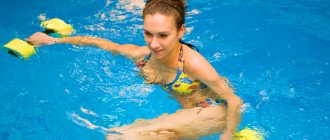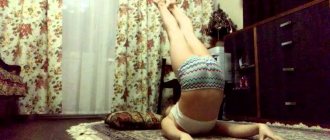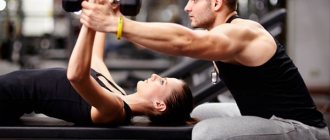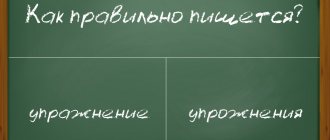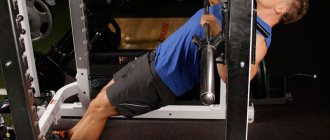Aerobics is a great way to stay fit, have a toned, lean body and exude self-confidence! This is the key to activity and good mood, regardless of gender and age.
The word "aerobics" means "with oxygen." These are exercises that are vigorous and invigorating, last long enough, and are done regularly to keep the heart and lungs healthy. Typically performed in groups with an instructor and background music. This article discusses the concept of “aerobics” (what it is, its varieties, what are the benefits of exercise) and provides brief historical information. Interest in aerobics has been growing at lightning speed since the first days of its inception. An audience interested in good health and a beautiful body understands all its benefits. This type of exercise burns fat faster than any other type of exercise.
Exercises
Water aerobics
A set of exercises includes walking, running, jumping, and flexibility exercises. The result of regular aerobics is keeping the body in good shape, training muscles and skin, and overall improvement of the body. Used for preventive and therapeutic purposes.
A combination, or composition, is a dance using the basic elements of aerobics, performed synchronously by a team of 8, 6, 3 people, a man-woman pair or solo. The duration of the sequence, from 1 minute to 3.5 minutes, is established by the rules of a particular event.
The main components of the ligament: jack, lunch, skip, jump, knee/knee-up, step, run, chasse, mamba, overlap, forward swing (kick, kick), swing to the side (side, side), heat (tap) and others.
Dance elements are physical exercises or jumps, the number of which is determined by the competition rules and the category to which the team belongs.
Elements of dance in the category “health aerobics”
- push-ups on the knees;
- balance (standing on one leg, not bent at the knee, motionless, tilting the body parallel to the floor and straightening the second leg and the opposite arm horizontally so that they form a straight line with each other and with the body);
- pistol corner (raising one leg horizontally to the floor on your arms with your abdominal muscles, holding the other leg on your shoulder);
- “fold” (bringing the upper body together with the legs, sitting on the floor, with straightened knees and pointed toes);
- women's twine;
- “step-up” jump (a jump from two legs, spreading them out to the sides as much as possible, as soon as the stretch allows, and bringing them back in the air, landing on two legs together);
- “horse” or “kangaroo” jump (jump from two legs while simultaneously pulling the knees to the chest).
Sports aerobics
Sports aerobics
Main article: Sports aerobics
- push-ups while lying down, push-ups while lying down with your elbows back;
- corner of the legs together (horizontal raising of the legs above the floor on the hands with the abdominal muscles for 4 or 8 counts);
- rotation of the angle by 90, 180 and 360 degrees;
- "horse";
- step-up (a jump from two legs at the same time, using the muscles of the legs and abs, spreading the legs in the air as far as stretching allows, while bringing the legs almost to the horizontal with some “folding” of the body forward);
- "fold";
- crawling through the splits, swing and others.
The number of elements and the degree of their implementation depends on the age and sports category of the team.
There are recreational aerobics, sports and recreational aerobics, and sports aerobics. There is also basic aerobics (without additional equipment and elements), step aerobics (using a step platform), fitball aerobics (aerobics on fitballs).
Training principle
Aerobics is a training type of activity aimed at improving the cardiorespiratory system. It is worth remembering that only certain types of fitness can burn the maximum number of calories (types of aerobics are described below). It is important to note that losing excess weight occurs rather slowly. And in order to speed up this process, it is necessary to relegate the healing effect to the background by training more than 3 times a week for 1.5 hours. The desired result will be noticeable only after 6 months. But a boost of energy and good health will appear after a month of regular training.
Benefits of aerobics:
- shortness of breath disappears;
- metabolic processes occur faster;
- endurance increases;
- muscle tone increases;
- pulse returns to normal;
- the risk of atherosclerosis is reduced;
- oxygen transport through organs and tissues occurs faster;
- lung volume increases;
- Bones and heart are strengthened.
Both adults and children can engage in fitness. Preschool educational institutions mainly use such types of aerobics that help to establish coordination of movements, improve flexibility and plasticity, learn to control your body and control it in motion. Aerobics is health-improving. © https://ydoo.info/qa/vidy-aerobiki.htmlAlso, while performing exercises to music, attention and memory improve, emotional and volitional processes are normalized.
Doing aerobic exercise helps relieve stress. As a result, you can get not only a beautiful and toned body, but also excellent health. Strength training, of course, will affect weight loss, but you still need to eat right.
Aerobics in the USSR
| This section is missing references to information sources. Information must be verifiable, otherwise it may be questioned and deleted. You may edit this article to include links to authoritative sources. This mark was set on November 21, 2014 . |
| This article may contain original research. Add links to sources, otherwise it may be set for deletion. More information may be on the talk page. (November 21, 2014) |
| Check information. It is necessary to check the accuracy of the facts and reliability of the information presented in this article. There should be an explanation on the talk page. |
In the Soviet Union and Russia, from 1984 to 1992, 14 rhythmic gymnastics complexes were shown on Central Television.
- In 1984, the program debuted on screens with an episode hosted by the famous figure skater Natalia Linichuk. Performers: Elena Novozhilova, Zhanna Smirenina, Kaleria Studenikina, Irina Cherichenko, Dmitry Mishakov, Nikolai Tugov. Composer A. Kiriak, the introductory song is performed by Sergei Minaev.
- The second edition of aerobics was conducted by the no less famous ballerina Liliya Sabitova; it was shown on television from January to March 1985. The complex used melodies from the Dutch group “Stars on 45”. Performers: Elena Bukreeva, Alla Pravdina, O. Savelyeva, Kaleria Studenikina, Nikolai Tugov, Yuri Shcherbakov.
- The third complex of rhythmic gymnastics was taught by the Honored Master of Sports in artistic gymnastics Elena Bukreeva (March - April 1985). Composer: Jean-Michel Jarre (France). The running melody is “Time for business, time for fun” from the repertoire of Alla Pugacheva. The melody before the final part is “Who is to Blame” by Viktor Reznikov with a phonogram by Valery Leontyev. Performers: Elena Novozhilova, Alla Savchenko, E. Samsonova, Kaleria Studenikina, Nikolai Tugov, Yuri Shcherbakov.
- The host of the fourth complex was theater and film actress Elena Skorokhodova (May - June 1985). In this release, the music of the first three complexes was used, except for running (“The world around us is a complete confusion” by Hightower and Denny), lying down and an invigorating ending. Performers: Elena Bukreeva, I. Kolokolova, Alla Pravdina, Alla Savchenko, A. Ignatiev, Nikolay Tugov.
- The fifth edition of rhythmics was conducted by two presenters at once - Natalia Linichuk and Igor Bobrin. This is the first complex in which exercises in a standing position are divided into two parts: warm-up and the main part. The release was unusual in that the exercises were performed not only in gyms, as in previous complexes, but in nature (July - August 1985). Filming took place at the Dynamo Sports Palace, Izmailovsky Forest Park and on the bicycle track in Krylatskoye. Natalia Linichuk: “The first exercise is the left hand up, the right hand on the belt, one-two…”. For the first time, the sound range of the complex was presented entirely by compositions of one author - Z. Liepins (“Hard Nut” - warm-up, “Hard Nut-2” - the main part, “Hard Nut-2” (the sound is muted) - an episode with learning the exercises of the main part, “Shuttle” - running part (after warm-up), “Renaissance” - pulse check, final part, “Stars Again” - beginning, main part (first two exercises), sitting and lying exercises). A song performed by Vladimir Dubinin and the group “Ri. The fragment with learning the exercises of the main part at the beginning of the release
.
Now on the Internet this fragment is placed after
the main part, which is irrational. Performers - an experimental rhythmic gymnastics group led by Igor Bobrin, I. Kolokolova, L. Lomakina, Alla Pravdina, Alla Savchenko, B. Ivliev, A. Ignatiev, Nikolai Tugov, the ballet group of Alla Pugacheva (there is a version that the last participant with a braided oblique in a yellow-lilac dress - her daughter Kristina Orbakaite, although at that time she was 14 years old and it is unlikely that she took part in the filming). - The presenter of the sixth complex was again Elena Bukreeva (October - December 1986). The composer for this release is Chris Kelmi. Performers: L. Lomakina, Tatyana Onischuk, Alla Pravdina, O. Savelyeva, Alla Savchenko, E. Plotkin, Yuri Shcherbakov.
- The seventh complex was led by Igor Bobrin, classes were held both in the hall and outdoors in the winter season (January - March 1987). The author of the music for this complex is also Chris Kelmi. Voice-over: Elena Bukreeva. Performers: A. Antonova, E. Vasyukova, N. Karamysheva, O. Filippova, I. Lisovsky, I. Okunev.
- The eighth episode of aerobics was hosted by Natalia Efremova (Korkh) - the debut took place in May 1987. Performers - T. Kolomyets, N. Opletaeva, V. Palladyeva, L. Prokhorova, G. Rozovskaya, Svetlana Rozhnova, N. Serafimova, A. Ilchinin, B. Maslov, B. Opletaev, A. Semikov, children Lisa and Ilya ( children of presenter Natalya Efremova), at that time members of the children's ensemble “Kukushechka”.
- The ninth rhythmic complex was conducted by Svetlana Rozhnova, it is called “On the Sea”: aerobics classes are held in the southern resort of the Black Sea coast of the Krasnodar Territory - in the Dagomys microdistrict. The composer of the release is Vadim Lashchuk, leader of the Kyiv rock band “Display”. At the beginning of the complex, a short rap “Plasticity is gymnastics” was heard, which became the motto of this complex, and in the middle, in the running part, the song “The Joy of Movement” was played. The complex had an application that was broadcast on the Good Morning program - morning warm-up. There is information that the complex has been cut down (a white background is used in learning, as in the sixth complex). Performers: Alexandra Vasilyeva, Elena Zakharova, Tatyana Onischuk, Olga Mergeeva, Irena Cherne.
- The tenth episode broadcast on CT was “Apartment” (March - April 1989). Four presenters from previous editions took part in it: Natalia Efremova, Liliya Sabitova, Elena Bukreeva and Svetlana Rozhnova. It used the melodies of popular foreign disco hits. Performers are Natalia Efremova’s children Ilya and Lisa. Here Ilya has grown up, he is 5 years old. Filming took place at the VDNKh pavilion. This complex also had an application, which Natalya Efremova ran together with her son Ilya, in which they learned exercises specifically for children. Sergey Cheskidov interviewed the presenters while learning the exercises. At the beginning of the complex, Natalya Efremova was sorting out letters from fans of the program. There is information that the complex was cut down (Ilya learned to study in the living room).
- The eleventh aerobics complex (in the American style) was led by Svetlana Rozhnova and the then famous film actor Oleg Knysh. He appeared on television in May 1990. Also in June 1990, three additional complexes were shown, the presenters of which were constantly changing: the first - all participants in turn with Oleg Knysh, the second - Oleg Knysh, the third - Inna Ignatova. Performers: Elena Makaenkova, Victoria Tereshchenko, Tatyana Zimanova, Svetalana Semenova, Andrey Bobykin, Sergey Kondrashov.
- The twelfth complex was held against the backdrop of Russian nature to Russian folk melodies arranged by Yuri Poteenko. The presenter of the issue was Inna Ignatova (July - September 1990). Performers: Alla Dorofeeva, Tatyana Zimanova, Elena Makaenkova, Galina Meshcheryakova, Svetlana Semyonova, Victoria Tereshchenko, Oleg Knysh.
- The thirteenth complex was filmed in the USA. The host of this complex was Jane Fonda, with voice-over translation into Russian by Inna Ignatova (July - August 1991). This episode was broadcast until the collapse of the USSR.
- The fourteenth edition (June 1992) was conducted by the author of the set of exercises, choreographer, candidate of pedagogical sciences Olga Ivanova. Performers: Elena Makaenkova, Nikolay Shvachkin, Tatyana Mishurova, Elena Trush, Tatyana Zimanova, Svetlana Semyonova. The complex was again filmed in American style and became the last. Broadcast on Channel 1 Ostankino, it was not popular.
Since 2005, the complexes have been periodically repeated on the Nostalgia TV channel, with the exception of episodes from 8 to 14.
Steps with changing leading foot
Step-touch (2) *
This is a normal side step. Steps on two counts are usually (not always) made at least two at a time. Those. a step in one direction and a step in the other direction.
- step one foot to the side
- place the second leg next to the first (we start the next step with the same leg and step in the other direction)
We take the second step from the foot with which we finished the previous step.
Double Step-touch (2+2)
These are two side steps that are taken in the same direction (from one leg).
- step one foot to the side
- place the second leg next to the first
- another step with the first foot in the same direction
- place the second leg next to the first
This is the so-called step-touch.
- step one foot to the side
- touch the floor with the second foot in front of the first foot
Chasse (2)
Another option for the side step. This step has a so-called “broken” rhythm. You need to make three movements for two counts. One is one count, and “and-two” is the second count, for which you need to perform two faster movements.
- step one foot to the side
- place the second foot next to the first and take a step with the first foot in place
Step-lift (2) *
- front
- back
- side
A step in which a straight leg is extended in a certain direction (a leg swing is made).
- step one foot to the side
- swing the other leg in the desired direction (front - forward, side - to the side, back - back)
Step-kick (2) *
The name of the step is literally translated as “kick”.
- step one foot to the side
- bend the second leg forward at the knee in front of the first (make a kick)
This step is an overlap.
- step one foot to the side
- bend the second leg back at the knee (make an overlap)
Step-plie (2) *
In other words - squatting.
- step one foot to the side
- straighten the second leg without lifting it off the floor, and at the same time squat on the first leg
Knee-up (4)
Variation of the “knee” step for 4 counts.
- step forward with one foot (or forward in the opposite direction: if we step with the right, then forward to the left, if with the left, then forward to the right)
- bend the second leg at the knee
- return the second leg to the starting position
- return the first leg to the starting position
Grape-wine (4)
A step with the poetic name “grape wine”. Performed on the basis of the “double step-touch” step.
- step one foot to the side
- We place the second leg crosswise behind the first
- take one more step to the side with your first foot
- place the second leg next to the first leg
Repeat
This is not a specific step, but a command that calls for repeating one step several times. So, for example, the phrase “Repeat 2 knee” means that you need to take the “knee” step in one direction twice. In the account layout it will look like this:
- step one foot to the side
- bend the second leg at the knee
- return the second leg to the starting position
- bend the second leg at the knee
* – these steps have so-called “reverse steps”. Let me explain what this means. All steps marked with an asterisk in the movement diagram represent first a step with one leg, and then some action with the other leg. So, for example, “step-kick” is “step-kick”. In the case of reverse steps, these actions are reversed. Those. First a “kick” is done, and then a “step”. The reverse steps are called accordingly: “kick-step, curl-step, etc.” Reverse steps are used infrequently by coaches, but nevertheless, their existence should not be forgotten. The number of counts for which the reverse step is performed is exactly the same as for the forward step.
httpv://www.youtube.com/watch?v=embed/BjUvAq4BB0A
Music for aerobics
In 1983, Electrola released an album by the Aerobic Sound Band, entitled “Aerobic - Dancing”. The album is made in the form of non-stop disco[1]. Break Dance were released in 1984 and 1986.
and
Break Dance 2
by the Romanian group Electric-Cord Group, recorded in synth-pop and funk style.
In 1985-1986 she released a series of records “Sports and Music” with instrumental electronic music. It includes the following albums:
- “Rhythmic gymnastics” (announcer - Olga Chipovskaya, music performers - pop orchestra under the direction of Pavel Ovsyannikov, instrumental ensemble of Rosconcert under the direction of Vladimir Osinsky, instrumental ensemble "Radar" under the direction of Sergei Pedersen, VIA "Opus" under the direction of Sigmar Liepins , Vadim Kondratyev, Andrey Rodionov and Boris Tikhomirov)
- "Pulse-1. Musical computer" (authors and performers of music - Andrey Rodionov and Boris Tikhomirov)
- “Pulse-2” (music performer - VIA “Opus” under the direction of Sigmars Liepins)
- "Pulse-3" (music performer - jazz-rock band "Arsenal" under the direction of Alexey Kozlov)
- "Aeroton" (music performer - instrumental ensemble of Rosconcert under the direction of Vladimir Osinsky).
In 1988, the album of the same name by the studio duo “Display” was published, the participants of which were Kiev musician Vadim Lashchuk and his wife Ellen Kreis. The instrumental piece “Ten Thousand Meter Race,” which occupied the second side of the record, was used in the ninth edition of rhythmic gymnastics “On the Sea.” Also in this program his song “The Joy of Movement” is heard. Previously it was assumed that Lashchuk himself acted as the disc jockey, but in fact it was a DJ from Sochi, Alexander Gorbunov.
For aerobics, specially recorded music is used without gaps between songs (tracks). Typically the duration of the disc is 50-60 minutes, at the end a composition for stretching and relaxation is added. For each type of aerobics, music of different intensity (frequency) and style is used. For example, for step aerobics, the impact is usually 130-136, 132-138 beats per minute, for box aerobics - 135-145 and higher.
Choosing a step platform for home training
When choosing a step platform, you need to focus on the following indicators:
- Step sizes. The length should vary from 0.8 to 1.2 meters, the width should be at least 40 cm. With such dimensions, the step platform is the most stable, it is easy to coordinate movements and maintain balance, and in case of an unsuccessful step, the risk of injury is minimized. The step should be adjusted by 2-3 levels of height, which makes it possible to gradually increase the load and not lose the effectiveness of physical development. The lower level of the step platform should be 10-15 cm. There are two types of height adjustment: using removable sections and using reconfiguration of the supports. The latter type is more preferable, since configurable supports are more stable and stronger than collapsible sections and they do not get lost, since they are always attached to the step.
- Design and materials of the step. High-quality step pads consist of durable plastic with a metal frame inside. The surface of the platform must have a rubberized coating to prevent slipping and injury. It is desirable that the soles of the supports are also rubberized or have a cellular structure to ensure stability of the step on a smooth floor. When choosing a step platform, jump on it: the board should not bend or spring.
- Step weight. The step must weigh at least 8 kg. Next, you need to proceed from your own body weight: the greater it is, the heavier the step should be (a platform weighing 15 kg can withstand a load of 120 kg). When choosing a step platform, stand with both feet on its edge, both in width and in length, and lightly spring the step, the step should stand on all supports and not turn over.
Data
- Aerobics exercises are demonstrated by the Turtle in the cartoon “Treasure”.
- Footage of aerobics was shown during the performance of the song “Jim Observes the Daily Routine” (“Song about the Benefits of Sports”) in the cartoon “Treasure Island.”
- The passion for aerobics was ironically played out in the plot of the film magazine “Yeralash” “Breathe Deeply!” [2] and in the video for the VIA “Ariel” song “You are old, old people” [3].
- In 1983, the song “Aerobics” was released (music by Y. Krupnik, lyrics by S. Kutanin). The song was performed by the Chisinau VIA “Arta” and VIA “Ariel”[4].
- One of the aerobics exercises appears in the song "Luck" from the 1985 TV musical film One for All. Nikolai Karachentsov sings.
- A song about aerobics (music by A. Dergachev, lyrics by V. Levin) is heard in the children's film “Malyavkin and Company” (1986)[5][6].
- In the film “The End of Operation Resident” (1986), Olga Kostrova (actress Irina Rozanova) performs a set of exercises that is shown on TV (the third set with Elena Boukreeva).
How to start practicing?
Before you start doing aerobics, you should always consult your doctor. When choosing a particular type of fitness, you should first of all take into account your health status, as well as individual characteristics.
Aerobics can be done both at home and in gyms in groups or individually.
For beginners, it is advisable to go to gyms where there are instructors and exercise machines. Trainers will take into account diseases (if any), help you choose a set of exercises to restore your health, and also choose the required level of physical activity.
If you want to lose weight, then you need to exercise up to five times a week. After two months of regular training, the result will not be long in coming. If you just need to keep yourself in excellent physical shape, then you can do aerobics three times a week.
If you want to achieve an ideal figure, you need to combine various activities (for example, go to the gym twice a week and do fitness three times a week). At the same time, you need not to be lazy and go towards your goal.
Aerobics[edit | edit code]
Aerobics
is a form of exercise that combines rhythmic aerobic exercise with stretching and strength training to improve all elements of fitness (flexibility, muscle strength and cardiovascular fitness).
Usually aerobics is done to music and in a group under the guidance of an instructor (fitness trainer), although it can be done alone and without musical accompaniment. Aerobics returns with fashion
Features
:
- Exercise for the muscles of the whole body
- Uses multiple joints
- Open or closed kinetic chain depending on the nature of the exercise
- Overcoming your own body weight
- The load can be constant or variable
- Sometimes requires special and fairly developed skills
- For all levels - from beginner to advanced
Classic aerobics - a brief history
The founder of classical aerobics is the American, Air Force Colonel and Doctor of Medical Sciences, Kenneth Cooper. It was he who first introduced the term “aerobics” in 1968 and published his first book of the same name.
Jane Fonda made aerobics popular.
The world owes the spread of the ideas of Dr. Cooper, who worked mainly for the US Air Force, to the Hollywood actress and fashion model Jane Fonda. In the late 70s, based on Cooper's books, she developed a system of aerobic exercises performed to rhythmic music. Having also published her findings, she released a number of videotapes with simple and understandable instructions for everyone.
Nowadays it is difficult to imagine a fitness club that would not offer at least 2-3 aerobic or “cardio” areas (basic aerobics, step aerobics, dance aerobics, aerobics with elements of kickboxing, etc.). All these directions were invented by processing and modifying the basic steps of classical aerobics.
How to choose clothes for aerobics?
Since the exercises are performed quickly, clothing should be comfortable and light: tracksuit, T-shirt, shorts, T-shirt, leggings. It is equally important to choose the right shoes. Regular sneakers are not suitable for jumping rope because they do not adequately support the lower leg. Exercising in them will become traumatic and can lead to problems with joints. For such purposes and some training from the eastern group, tennis or basketball sneakers are more suitable. It is also worth bringing a towel, mat, and water with you to the lesson.
Many beginners wonder: is it too late for me to do aerobics? The answer is no. Aerobic training is suitable for people of all ages and different fitness levels. If solo training at home requires independent control, then in group training you can be inspired by the successes of others and meet interesting people. Don't miss the opportunity to find your dream figure, rejuvenate and brighten your life!
How the competition works
Persons over 18 years of age are allowed to compete. To do this, the athlete will have to demonstrate exercises reminiscent of freestyle from artistic gymnastics, without the use of technically complex elements. However, it must be performed at a high rhythm and to special music that has a clear rhythm. By their nature, they will be sharp and dynamic, distinguished by completeness.
The competition lasts for 3 days, of which two will be qualifying days and the third will be the final.
There are 4 types of programs:
- individual;
- male and female;
- mixed;
- among the triplets.
The composition must be shown for 115 seconds. A deviation of ± 10 s is allowed.

